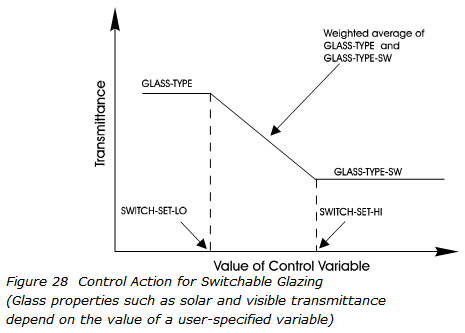EnergyPlus has an object called WindowProperty:ShadingControl that accepts a "Switchable Glazing" option, and then you define a switch point, such as solar radiation: below it's fully clear, above it's fully tinted.
This is fine and easy to setup for a binary case (fully clear/dark). As stated in the documentation: "When a shading device is present it is either retracted or activated. When it is retracted it covers none of the window. When it is activated it covers the entire glazed part of the window (but not the frame)".
How do you go about modeling a dynamic electrochromic glazing, when the glazing can take any given state in between fully clear and fully dark?
1.Is it possible to have some interpolation in between? Something along the line of this (which is from eQuest's help file):

2.If not, which is what I think, I'm ok defining 4 or 5 intermediate steps (should approximate good enough). I think I'll use an EMS program to do that (would love to be proven wrong/have just missed a built-in function), but I'm unclear what variable would be equivalent to the "solar radiation". I'm guessing "Surface Outside Face Incident Solar Radiation Rate per Area". Is that correct?





